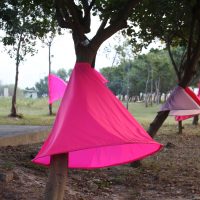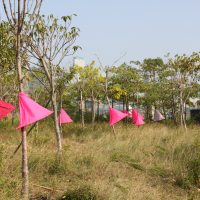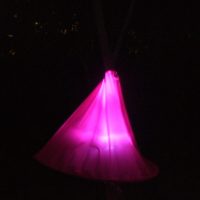Second Skin was a collaborative effort between myself, my colleague at the time Tricia Flanagan, and a group of five AVA students.
The site of the HK-SZ Bi-City Biennale of Urbanism/Architecture 2009 was also the Biennale’s largest exhibit: an urban wilderness on artificial land in the very heart of the city: A habitat for various mammals, birds, but especially insects and vegetation of all kinds is not something generally associated with metropolitan city-centres. In particular Hong Kongers are not usually exposed to ‘un-tamed’ nature, and often feel uncomfortable or even threatened by it.
Second Skin domesticated the wildness of the site through a fashion-intervention: various clusters of trees were ‘dressed’ with simple, cone-shaped ‘hoop skirts’ around their trunks. It introduced into the wilderness a clearly artificial icon, a simple, logo-esque sign, that contradicted the presence of the site, exposed its past as land-reclamation and reconciled it with its future as a cultural district dedicated to the arts.
The balance of abstract shapes and natural trees, the contrast of colours, the visual relations between cones, trees and the skyline of the ICC turned the site into an abstract, walk-through sculptural object and space, changing according to daytime, weather-condition and growth of vegetation.
At a closer range the cone-skirts created a variety of spaces underneath them and between each other, which the visitors – especially the children – were invited to experience: walking through them, swinging them, hiding underneath. Doing so the visitors automatically left the given paths of the exhibition-site and got in closer contact with the nature of the place: the trees, the ground-vegetation, the fauna.
Further reference: Peter Benz. ‘Dressing Nature’. In Eric Schuldenfrei, and Marisa Yiu, eds. Instant Culture: Architecture and Urbanism as a Collective Process. Hong Kong: MCCM, 2011. p. 122–125.
- Second Skin in front of the ICC Tower
- Second Skin: A tree skirt close up.
- Skirts swaying in the wind.
- A tree school with skirts.
- Second Skin: A tree hamlet.
- Second Skin: Glow in the dark.
- The skirts at night.
- Second Skin: Night View







